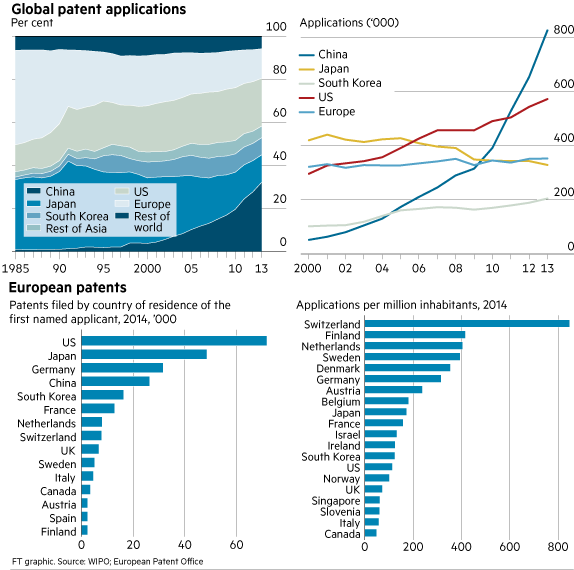外媒看中国:知识产权激增
For most of the past 30 years, the leaders in patent filing were without doubt Japan and the US, with Europe bumping along in third place. But from the early 2000s, China began to emerge as a significant force, and each year since 2011 more patent applications have been filed in China than in any other intellectual property office around the globe.
在过去的30年时间里,在专利申请方面,日本和美国是毫无疑问的领头羊,欧洲紧随其后。但是从2000以后,中国异军突起,从2011年开始后的每一年中国所申请的专利数目比全球其它任何一个国家都要多。
The initial rush was for domestically filed patents, but Chinese companies soon began looking for international markets, with the latest data from the European Patent Office (EPO) putting China fourth in the volume of patents filed in the EU last year, up from 12th less than a decade ago.
最开始的专利申请高潮出现在国内,但是中国公司很快开始寻找国际市场,根据欧洲专利公司的最新数据显示,2014年欧洲专利申请总数中,中国排名第四,较上一年上升了8个位次。
The majority of applications for patents in Europe now come from outside the continent, with Germany the only European country to make it into the top five. In total, more than 274,000 patents were applied for at the EPO last year, an all-time high.
欧洲的专利申请大部分来自于欧洲大陆以外的国家,只有德国专利申请可以跻身前五,去年欧洲专利公司接受的申请案例多达274000,是历年最高。

Part of the reason for the burgeoning number of Chinese patents in Europe is a need to catch up. China’s stock of international patents remains small compared with its research and development (R&D) spending. If Chinese companies are to compete for business in Europe, they will need to ensure that the IP underpinning their technology is owned by them and legal in the EU.
中国专利申请的总数激增的重要原因就是要迎头赶上。中国对国际专利的投资远不及其对研发的投入。如果中国公司想要与欧洲企业竞争,他们必须保证他们科技背后的专利是属于他们的,并且在欧盟是合法使用的。
As an indication of the importance that the Chinese government attaches to the issue, in 2012 it began offering subsidies for foreign filings in addition to those it offers for domestic filings.
意识到知识产权重要性的中国政府开始强调专利的重要性,并从2012年开始,不仅为国内知识产权申请提供补贴,更为国际专利申请提供补贴。
The often repeated charge that many of the patent applications from China are of low quality has some support in the data. While China accounts for about 10 per cent of patents filed to the EPO, when it comes to patents granted the proportion drops to 2 per cent.
但是中国的专利申请也有一个问题被人反复诟病,及其专利的质量较低。中国向欧盟申请的专利数目占总数的10%,但是最后能申请下来专利的项目,中国只占了2%。
The more knotty question is whether patent applications — or even those that are granted — tell us anything meaningful about the comparative state of innovation between countries.
但是一个更为关键的问题是,专利应用——甚至是那些获得专利的项目真能反应两个国家竞争状态吗?
The UK’s Intellectual Property Office, which is responsible for overall UK intellectual property policy as well as granting UK patents, trademarks and design rights, thinks not. “To approximate a level of innovation purely on patent numbers would be a one-dimensional, and woefully inadequate, way to understand the breadth of activity that characterises innovation,” according to a spokesman for the Office.
英国知识产权办公室不这么认为,它负责全英知识产权政策及英国专利、商标和设计权的授予工作。“如果只凭专利申请数目来判断创新的水平未免太单一了,而且也不够,远不能了解创新活动的广度。”该办公室的发言人如是说道。
Elena Novelli, lecturer at Cass Business School in London, is more measured, saying: “Certainly, the number of patents filed is a metric, but it is not the ultimate metric.” There are no hard and fast statistics on how many patents actually make money, but Bloomberg Business says that of 1.5m US patents in effect in the mid-2000s, only about 3,000 were commercially viable. Dr Novelli stressed that even among those which make money, their value can be very skewed, with a high number of inventions turning out not to have much value and only a few being of high value.
埃琳娜·诺伟利是伦敦卡斯商学院的讲师,他认为:“当然,专利申请数字是一个衡量标准,但是并非最终的衡量标准。”关于多少专利能真正盈利并没有确凿的数字,但是彭博商业周刊称在2000中期,美国申请了150万个专利,但是只有3000个专利是有商业回报的。诺伟利强调,即使在那些有商业回报的专利中,其商业利润也有限,大量的专利都没有什么商业价值,只有极少数具有很高的商业价值。

